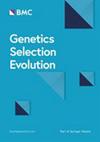Exploring skeletal disorders in cattle and sheep: a WGS-based framework for diagnosis and classification
IF 3.1
1区 农林科学
Q1 AGRICULTURE, DAIRY & ANIMAL SCIENCE
引用次数: 0
Abstract
Genetic skeletal disorders are a heterogeneous group of syndromic or non-syndromic diseases characterized by abnormal bone, joint or cartilage development. These disorders generally occur sporadically in ruminants. Although a genetic etiology is often suspected, only a limited number of causal variants have been identified and no comprehensive genetic analyses of a cohort of bovine and ovine skeletal developmental defects have been published. The aims of our study were (1) to propose a nosology of genetic skeletal disorders in cattle and sheep and (2) to contribute to the nosology with a number of novel genomically characterized cases. Based on a literature review, the proposed nosology of skeletal disorders in cattle and sheep with a confirmed molecular cause was found to comprise 43 different disorders associated with 45 different genes. In addition, horn traits were also included. The disorders were grouped into 21 categories based on the human medical nosology. Thirty novel bovine and nine ovine cases of congenital skeletal disorders were investigated. These represented 19 different disorders, which were grouped into 9 categories. Whole-genome sequencing (WGS) data were generated based on sample availability for either complete trios, affected paternal halfsiblings or isolated single cases. We identified 21 SNVs or small indels for 12 skeletal disorders. Of these, 17 were considered candidate variants affecting 16 different genes, including 11 that were classified as pathogenic and six as likely pathogenic. Additionally, the remaining 4 SNVs were of uncertain significance. Two aneuploidies (trisomy and partial monosomy) were the cause of two different disorders. For eight cases affected by six disorders no variant could be identified. Different modes of inheritance were detected, including spontaneous dominant de novo mutations, autosomal recessive alleles, an X-linked dominant allele, as well as aneuploidies. The overall molecular genetic diagnostic rate was 64%. Genomic analysis revealed considerable heterogeneity of the described phenotypes in terms of mode of inheritance, affected genes, and variant type. We propose, for the first time in veterinary medicine, a nosology of genetic skeletal disorders in ruminants that may be useful for more precise differential clinicopathological diagnosis. We emphasize the potential of WGS to enhance genetic disease diagnosis and the importance of adopting a nosology for disease categorization.探索牛羊骨骼疾病:基于wgs的诊断和分类框架
遗传性骨骼疾病是一组异质性的综合征或非综合征性疾病,其特征是骨骼、关节或软骨发育异常。这些疾病通常在反刍动物中零星发生。虽然遗传病因经常被怀疑,但只有有限数量的因果变异被确定,并且没有对牛和羊骨骼发育缺陷队列的全面遗传分析已发表。我们研究的目的是:(1)提出牛羊遗传性骨骼疾病的分类学,(2)通过一些新的基因组特征病例为分类学做出贡献。在文献综述的基础上,提出了牛羊骨骼疾病的病原学,发现有确定的分子原因,包括43种不同的疾病,与45种不同的基因相关。此外,牛角性状也包括在内。根据人类医学分类学将疾病分为21类。本文报道30例新型牛和9例绵羊先天性骨骼疾病。这些代表了19种不同的疾病,分为9类。全基因组测序(WGS)数据是基于完整的三人组、受影响的父亲同父异母兄弟姐妹或孤立的单个病例的样本可用性生成的。我们确定了12种骨骼疾病的21个snv或小索引。其中,17种被认为是影响16种不同基因的候选变异,其中11种被归类为致病性,6种被归类为可能致病性。另外,其余4个snv的意义不确定。两种非整倍体(三体和部分单体)是两种不同疾病的原因。在受6种疾病影响的8例病例中,没有发现变异。检测到不同的遗传模式,包括自发显性新生突变、常染色体隐性等位基因、x连锁显性等位基因以及非整倍体。总体分子遗传学诊断率为64%。基因组分析显示,在遗传模式、受影响基因和变异类型方面,所描述的表型具有相当大的异质性。我们首次在兽医学中提出反刍动物遗传骨骼疾病的分类学,这可能有助于更精确的临床病理鉴别诊断。我们强调WGS在提高遗传病诊断方面的潜力,以及采用疾病分类学进行疾病分类的重要性。
本文章由计算机程序翻译,如有差异,请以英文原文为准。
求助全文
约1分钟内获得全文
求助全文
来源期刊

Genetics Selection Evolution
生物-奶制品与动物科学
CiteScore
6.50
自引率
9.80%
发文量
74
审稿时长
1 months
期刊介绍:
Genetics Selection Evolution invites basic, applied and methodological content that will aid the current understanding and the utilization of genetic variability in domestic animal species. Although the focus is on domestic animal species, research on other species is invited if it contributes to the understanding of the use of genetic variability in domestic animals. Genetics Selection Evolution publishes results from all levels of study, from the gene to the quantitative trait, from the individual to the population, the breed or the species. Contributions concerning both the biological approach, from molecular genetics to quantitative genetics, as well as the mathematical approach, from population genetics to statistics, are welcome. Specific areas of interest include but are not limited to: gene and QTL identification, mapping and characterization, analysis of new phenotypes, high-throughput SNP data analysis, functional genomics, cytogenetics, genetic diversity of populations and breeds, genetic evaluation, applied and experimental selection, genomic selection, selection efficiency, and statistical methodology for the genetic analysis of phenotypes with quantitative and mixed inheritance.
 求助内容:
求助内容: 应助结果提醒方式:
应助结果提醒方式:


